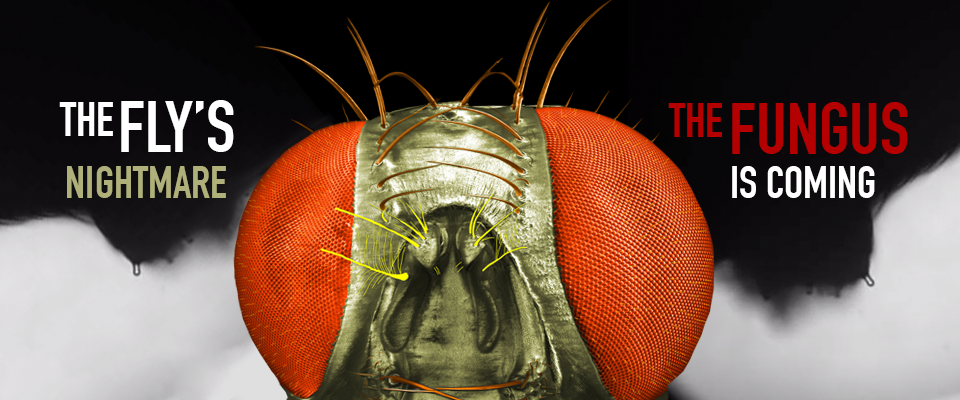As the sun set on Berkeley one evening in 2015, a fruit fly, whom we’ll call Bill, crawled his way up the tender green skin of a watermelon. Moving slowly, as if hypnotized, he reached the top of the melon, extended his proboscis and released a gluey gunk that gently adhered his tiny limbs to the fruit. His body tensed as his wings pulled up and back behind him; he was still as a statue—poised, elegant.
Then the mind-controlling parasitic fungus burst from Bill’s torso like a fluffy white cloud of hell goo, releasing spores to infect other flies and consume their organs in turn. Minutes after the intruder had been exorcised, Bill lay shriveled atop his own, fixed limbs. Motionless. Dead. It was the end of another beautiful day in Berkeley, California, and the end of another beautiful life.
The Destroyer takes over the fruit fly’s brain and nervous system early on, while consuming all of its fatty tissue and starving the fly from the inside out.
But it was also the beginning of something big for biochemist Carolyn Elya, who discovered that fruit flies were being infected by the fungus Entomophthora muscae (Greek for “The Destroyer of Insects”) when she left a watermelon to rot on her front porch. She recognized the cream-colored schmutz on the outside of the flies’ dilapidated carcasses as a hallmark of parasitic fungal infection, and she had a hunch that this was another case of fungus mind control.
To test her hypothesis, she returned to her UC Berkeley lab, where she was then a doctoral student, for more potential victims. After confirming, microscopically, the type of fungus, henceforth known as The Destroyer, she brought home a batch of laboratory fruit flies—Drosophila melanogaster—and proceeded to infect them as well. Until that point, E. muscae infections of fruit flies had only ever been reported in the wild, making Elya and her team members the first to study a naturally Drosophila-infecting strain of E. muscae in a laboratory setting.
What she observed seemed like a case for Mulder and Scully.
Elya learned that The Destroyer takes over the fruit fly’s brain and nervous system early on, within the first 48 hours of infection, while consuming all of its fatty tissue and starving the fly from the inside out. Once the fat stores have been absorbed by the fungi, The Destroyer starts gobbling up the flies’ organs, while forcing the victims to fly someplace high to roost, and die. Before they know it, or don’t know it, the flies are glued down by their appendages, unable to move—as The Destroyer eats their brains and the remaining muscles in the body. It then forces the fly’s wings upward and back at a stark 90-degree angle, so that nothing will block the fungus as it ejects itself from their mutilated corpse like plant fuzz from a chia pet. From this high perch, the spores can spread widely, launching themselves into the wind at 20 miles per hour to infect new hosts.
Studying how the fungi control their insect hosts could lead to a better understanding of how behavior is coded in the brain, Elya said, and how that behavior might be regulated.
Perhaps you’re thinking: Poor Bill! Why would a fungus be so cruel? So uncaring? So… inhuman?!
The answer is simple, according to Elya: Fungi’ve gotta eat.
“Some fungi have just figured out that insects are a really good source of food. When you get inside of [insects], it’s basically a buffet,” Elya explained. “It’s not as atypical as you might think… Fungi are a diverse group and they find food in all kinds of places.”
A famous example of this is Ophiocordyceps unilateralis, otherwise known as ZOMBIE ANT FUNGUS. Known to infect Camponotus leonardi—an ant species found in Thailand, Africa and Brazil—the fungus lies in wait on the forest floor for an unsuspecting ant to brush against it. For about a week, the fungus manifests in the ant’s body, and as the ant reaches the end of its life, the fungus manipulates it to (uncharacteristically) abandon its colony and walk 25 centimeters up a tree—seemingly aimlessly, like a zombie. Now placed in a prime, humid spot for the fungus to grow, the ant is forced to clamp down on a leaf and die, allowing the fungus to explode from the back of the ant’s head and shower spores upon the forest floor.
How exactly the Zombie Fungus and The Destroyer learned to practice this kind of mind control remains a mystery. But Elya said that it can likely be chalked up to an accident of nature, that such fungi stumbled upon a way to produce a molecule that manipulates neuronal functioning. In the case of The Destroyer, Elya theorized, the molecule allows the fungus to control a fly’s flight, for better dispersal of spores and genetic information.

Studying how the fungi control their insect hosts could lead to a better understanding of how behavior is coded in the brain, Eyla said, and how that behavior might be regulated.
“Understanding how this works in flies might give us an idea of how this works in humans,” Elya said. “If there’s a molecule that the fungus is making that’s changing the way that the fly’s brain is working, what is that molecule? And can that molecule be used for other purposes?”
She imagined a possible molecule that could change the influence of neurotransmitters in someone’s brain to help with mental illness. Perhaps, Elya said, “we could tamp down the response of these neurons that are maybe implicated in abnormal or undesirable behavioral responses of people.” She added that such questions are still, “very hypothetical.”
Despite the horrific death sequences that poor flies like Bill endure, Elya said that while The Destroyer may appear big and bad, it is hardly indestructible.
Elya theorized that there may be a greater purpose for the fungi. “I think of it as a natural population control mechanism,” she said, adding that “it’s probably important for balancing the numbers of flies.”
Case in point: It wasn’t easy for Elya to infect her lab flies in the first place because the basic anti-fungal she puts in their food was enough to shield them. Once that was removed, the infection succeeded, but only after Elya directly administered the fungal spores. During the first two days of infection, Elya observed a strong immune response from the flies, suggesting that the flies might have knocked out the fungus if she weren’t so adamant about infecting them.
“The flies [in the lab] got hit with a lot of fungus, and flies that are that heavily infected in most cases aren’t able to fight off the infection,” Elya said. “But you can imagine, in nature, if a fly gets hit by a single spore, then it has a fighting chance.”
Also, the dead flies are only contagious for 24 hours after they die, so if other flies don’t get up in the dead ones’ business, the fungi won’t spread fly-to-fly. Also, if a spore lands on a surface that’s not a fly, they only have one more chance to launch a final spore, and if that spore misses its mark, it too will dry out and die.
These limitations mean that the fungus can only wreak serious havoc in large groups of flies. And so Elya theorized that there may be a greater purpose for the fungi. “I think of it as a natural population control mechanism,” she said, adding that “it’s probably important for balancing the numbers of flies.”
But what if The Destroyer decides it wants to “balance the number” of humans someday?
“The fungus is super specialized to eat flies. It can’t even infect other types of insects—it’s specific to flies,” Elya said. “There’s a very, very, very remote chance of the fungus ever naturally coming to harm humans.”
Comforting words for us. Pour one out for Bill.
Elya’s study was published last month in the journal eLife.
Krissy Eliot is senior associate editor at CALIFORNIA. You can find more examples of her work and her contact info at www.krissyeliot.com.



















